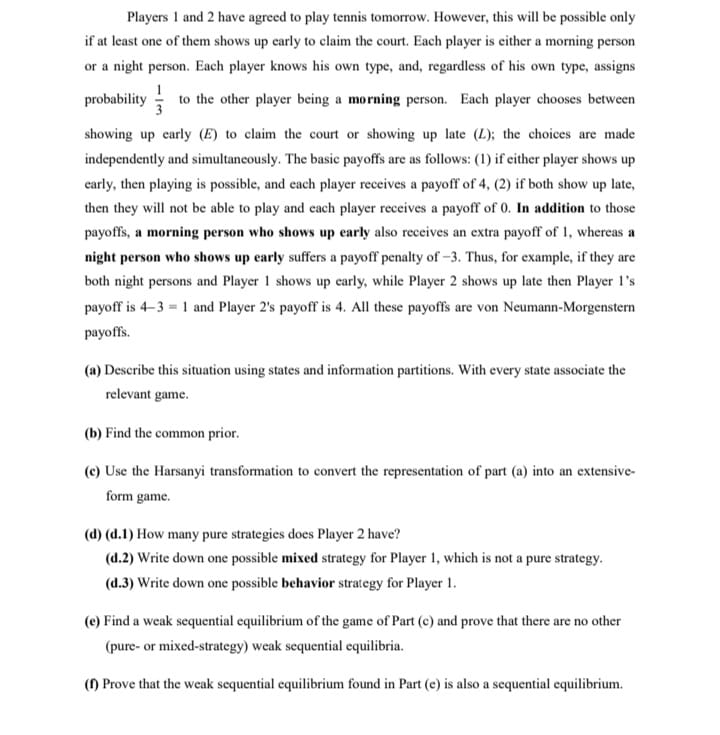

In class we saw a stronger version of the first fundamental theorem of welfare economics (FFTWE) for exchange economies than for production economies. We also had to work hard to prove the second fundamental theorem (SETWE) for production economies. In this exercise you obtain: (i) a strong version of the FFTWE for production economies; and (ii) a simple proof of the SETWE for exchange economies. 1. Consider a production economy (7.d. (u'. when. (Yea, (s" )(weaxal. where each u' is locally-nonsatiated and Y * @. Suppose that there are as many firms as there are individuals, and that s' = 1 for all i. Say that an allocation (x, y) is in the core of this production economy if there do not exist H( C J and (x', y' hear such that:' (a) for all i e H, y' EY; ( b ) [iEX x = [lex w + [sexy!: (c) for all i E H, u' (&') > u'(x' ); and (d) for some i E H, u' (8' ) > u'(x'). Argue the following version of the FFTWE for this economy: If (p. x, y) is a competitive equilibrium, then allocation (x, y) is in the core of the economy. 2. Consider a society ], where the preferences of the individuals are represented by the utility functions (u' : R4 + RJigg. Assume that all these functions are continu- ous, strictly quasiconcave and strictly monotone. Recall that, given these assumptions, our existence theorem says that for any profile (wiles of individual endowments, ex- change economy (3, (u'. when) possesses a competitive equilibrium. Now, using this existence result: (a) Argue that if a profile of individual endowments (wiley is a Pareto efficient al- location, then there exist prices p such that the pair (p, (whey) is a competitive equilibrium of the exchange economy {], (u', whes)." (b) Argue the following version of the SETWE: Fix initial endowments (when. If allocation & = (& hey is Pareto efficient, then there exists (p. (when) such that I, w = [, w and (p. &) is a competitive equilibrium for economy (], (u', w')(es).This question consists of two independent parts, each of which carries one half of the ques- tion's grade. 1. Let J, = (1,..., I,] and ], = (1, + 1, ..., I, + I,) be two (disjoint) local societies, and denote by ] = J, UJ, the global society resulting from their integration. For each individual in these societies, let u' be continuous, strongly quasiconcave and strictly monotone, and let wi E R. . In this exercise you are going to argue that each society can protect itself against any damage brought about by globalization. For each local society, k = 1,2, let (p*, (x' )ies, ) be a competitive equilibrium of ex- change economy (3k, (u', when, ). Show that there exist (wiley such that: (a) for each k = 1,2, Zie], Wi = Lies, wh; and (b) for any competitive equilibrium (p, (x' Jes) of the (global) economy (], (u', whea) one has that u' (x' ) > u' (x' ), for all i ( J. (Hint: The claim is that each society can implement a local fiscal policy that guarantees that any global equilibrium is Pareto superior, for itself, to its own local equilibrium. Now, how would you make sure that nobody can be made worse off, through voluntary trade, than at some given allocation?) 2. In a standard exchange economy {], (u', whey) the distribution of wealth is biased in favour only of agent 1 if for any competitive equilibrium (p, x) of the economy the following three properties are true: (a) for each i > 2, u' (x') > u' (x) for every x such that p . x 2, there exists x such that p . x u'(x' ); and (c) for every i. j > 2, u'(x') > u'(x) for every x such that p . x w. for all individuals, where w, is some minimal bundle. Determine assumptions under which fiscal policy can ensure that the distribution of wealth is biased in favour only of agent 1 and permits subsistence. State your claim formally and prove it.Players 1 and 2 have agreed to play tennis tomorrow. However, this will be possible only if at least one of them shows up early to claim the court. Each player is either a morning person or a night person. Each player knows his own type, and, regardless of his own type, assigns probability to the other player being a morning person. Each player chooses between showing up early (E) to claim the court or showing up late (2); the choices are made independently and simultaneously. The basic payoffs are as follows: (1) if either player shows up early, then playing is possible, and each player receives a payoff of 4, (2) if both show up late, then they will not be able to play and each player receives a payoff of 0. In addition to those payoffs, a morning person who shows up early also receives an extra payoff of 1, whereas a night person who shows up early suffers a payoff penalty of -3. Thus, for example, if they are both night persons and Player 1 shows up early, while Player 2 shows up late then Player I's payoff is 4-3 = 1 and Player 2's payoff is 4. All these payoffs are von Neumann-Morgenstern payoffs. (a) Describe this situation using states and information partitions. With every state associate the relevant game. (b) Find the common prior. (c) Use the Harsanyi transformation to convert the representation of part (a) into an extensive- form game. (d) (d.1) How many pure strategies does Player 2 have? (d.2) Write down one possible mixed strategy for Player 1, which is not a pure strategy. (d.3) Write down one possible behavior strategy for Player 1. (e) Find a weak sequential equilibrium of the game of Part (c) and prove that there are no other (pure- or mixed-strategy) weak sequential equilibria. (n) Prove that the weak sequential equilibrium found in Part (e) is also a sequential equilibrium











